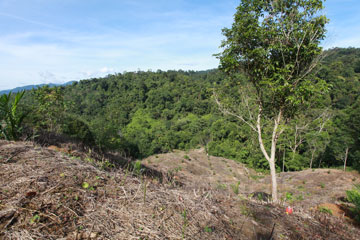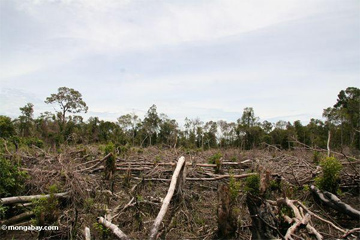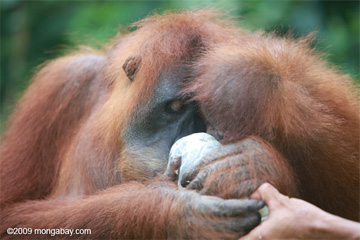Growing numbers of “palm oil orphans” in rehab centers present a challenge to conservationists.
NOTE: A shorter version of this article was published on Yale e360 in June.
A baby orangutan ambles across the grass at the Borneo Orangutan Survival Foundation’s Nyaru Menteng rehabilitation center in Central Kalimantan, in the heart of Indonesian Borneo. The ape pauses, picks up a stick and makes his way over to a plastic log, lined with small holes. Breaking the stick in two, he pokes one end into a hole in an effort to extract honey that has been deposited by a conservation worker. His expression shows the tool’s use has been fruitful.
But he is not alone. To his right another orangutan has turned half a coconut shell into a helmet, two others wrestle on the lawn, and another youngster scales a papaya tree. There are dozens of orangutans, all of which are about the same age. Just outside the compound, dozens of younger orangutans are getting climbing lessons from the Borneo Orangutan Survival Foundation (BOS) staff, while still younger orangutans are being fed milk from bottles in a nearby nursery. Still more orangutans—teenagers and adults—can be found on “Orangutan Island” beyond the center’s main grounds. Meanwhile several recently wild orangutans sit in cages. This is a waiting game. BOS hopes to eventually release all of these orangutans back into their natural habitat—the majestic rainforests and swampy peatlands of Central Kalimantan, on the island of Borneo. But for many, this is a fate that may never be realized.
 Kalimantan, 2009 |
The goal of the BOS project is reintroduction, but many of these apes may be destined for a life in captivity. The reason? Suitable habitat in Borneo and Sumatra, the two islands that are home to the world’s entire population of wild orangutans, is increasingly scarce. Economic returns from converting verdant rainforests into furniture, paper, woodchips, and oil palm plantations have rapidly diminished the availability of sites for reintroduction, while dramatically boosting the number of orangutans in need of rescue.
So the orangutans must wait. But they are the lucky ones. For every orangutan housed in the center, half a dozen or more may have fallen victim to deforestation or the pet trade, or met their end at the blade of a machete or the blunt end of a iron bar—estimates range from 1,500-5,000 per year. Perhaps worse, some reintroduced orangutans have managed to win taste of freedom only to see their new home destroyed by loggers and oil palm developers.
– – – – –
Orangutan rehabilitation centers originally emerged as a response to the pet trade. Until very recently in much of the world (and even today in parts of Asia and the Middle East), there has been demand for orangutans as circus performers, entertainers for TV shows, occupants of zoos, and surrogate children for childless families. Before much was known about orangutan ecology, the first rehabilitation center was set up in the1960s by conservationist Barbara Harrison, who feared the species might be on the verge of extinction in the wild due to overcollection for the pet trade. Thus centers—including Ketambe and Bohorok in Sumatra’s Gunung Leuser National Park; Sepilok in Sabah, Malaysia; Camp Leakey in Central Kalimantan’s Tanjung Putting National Park; Semenggok in Sarawak, Malaysia; and Wanariset in East Kalimantan, among others—emerged as a way to care for confiscated orangutans in the hope of eventually reintroducing them to the wild. But caring for orangutans is difficult and costly. While baby orangutans score high for their cuteness factor, an adult orangutan, especially a full-grown male, is orders of magnitude stronger than a human and has substantial dietary requirements.
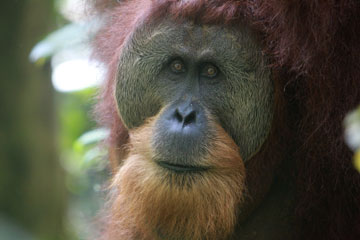 Sumatra, 2009
|
But while the flow of orangutans from the pet trade was relatively manageable, the rise of palm oil has changed the situation, greatly increasing the number of orangutans in need of care. Michelle Desilets, former director of BOS-UK and now executive director of the Orangutan Land Trust, says she started to see the shift about five years ago.
“Originally the great majority of our rescues were confiscations of privately (illegally) owned orangutans. Often these were held by senior police officers, the military or government officials, making it a challenge to successfully confiscate them,” she said.
“About five years ago, our rescue teams began to be informed of wandering wild orangutans in human settlements, and despite immediate response, the teams often found the orangutans to be dead on arrival, due to human/wildlife conflict. Why, suddenly, were there so many cases of wild orangutans being injured or killed by humans? It had to do with the conversion of their forest habitat for the cultivation of oil palm.”
Desilets says the wild orangutans, left in ever smaller fragments of forest, face starvation as their food sources are depleted, forcing them to venture into newly established plantations where they feed on the young shoots of palms, thereby destroying the trees before they produce any oil seeds.
“As a result, they are considered an agricultural pest. Plantation managers often offer a bounty on the head of these orangutans, and the $10-$20 reward is a strong incentive for a migrant worker.”
Desilets says that since workers usually do not carry guns, orangutans are brutally killed using whatever tools are at hand.
“Our teams have found orangutans beaten to death with wooden planks and iron bars, butchered by machetes, beaten unconscious and buried alive, and doused with petrol and set alight,” she said. “Since 2004 more and more orangutans in our centers have been rescued from areas within or near oil palm plantations, and over 90 percent of the infants up to three years of age come from these areas.”
– – – –
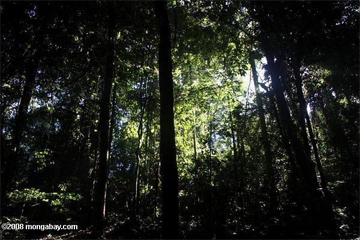
|
Indonesia and Malaysia are the world’s largest producers of palm oil, accounting for more than 85 percent of global production in 2008. Palm oil demand has risen sharply over the past two decades due to its wide use in foods, beauty products, and even as a feedstock for biodiesel. Accordingly, the area of land under cultivation in Malaysia and Indonesia has expanded rapidly, growing from less than 150,000 hectares in 1984 to more than 12 million hectares by the end of 2008. Much of this expansion has occurred at the expense of native forest, including prime orangutan habitat. For example, the area of habitat in Kalimantan shrank 39 percent, from 141,500 sq km in 1992 to 85,835 in 2002, while the extent of primary forest cover has decreased by more than 90 percent since 1975. Unlike logged-over forest, which has the capacity to support at least some orangutans—albeit in lower densities than found in intact forest—timber and oil palm plantations are not viable habitats for orangutans. If they can’t move to other areas—due to isolation or conflict with other orangutans—they will perish without human intervention.
But orangutan rehabilitation centers are ill equipped to handle this tide of “palm oil orphans.”.It can cost more than $2,000 per year to feed and care for an orangutan, which if it is an infant, may be reared for eight to tens years, perhaps longer. Further, there simply isn’t enough room in care facilities. A stark case can be seen in the training forest at Nyaru Menteng. Here young orangutans are taken for daily supervised “exploration” to enable them to gain experience in their native habitat. But use by 200 or so orangutans has taken a toll on the forest. Bark and leaves have been stripped from trees, leaving the ecosystem heavily degraded. (It seems that like humans, too many orangutans can tax a forest.)
 Kalimantan, 2006 |
It’s a similar case on the islands that house adult orangutans awaiting their release into the wild. Approaching on a powered dugout, it is clear these forests have been heavily impacted. But with so many orangutans and a finite area for them to live, there is little choice. The orangutans become accustomed to living in high densities never seen in the wild, behavior that carries implications for reintroduction.
Reintroduction can only occur after rehabilitation, except in the case of translocation—the transfer of wild orangutans from one location to another. But translocation can be stalled when orangutans need to be treated for illness or injury, forcing wild orangutans temporarily into the system. And there are many other issues that can complicate reintroduction.
First and foremost is whether the habitat is secure. With vast swathes of forest being logged and converted for plantations, finding safe forest is increasingly difficult, and there have been several recent instances where reintroduction sites have been cleared after reintroduction, with tragic consequences. Earlier this year Globalindo Agung Lestari cleared a section of forest near Mawas, a reserve in Central Kalimantan, where some 80 wild orangutans had been released. Hardi Baktiantoro of the Center for Orangutan Protection (COP), an activist group that investigates clearing of orangutan habitat in Kalimantan, says all the reintroduced orangutans likely perished. However since the area was granted as a concession by the government, there was nothing illegal about the clearing. In Sungai Wain, a protected forest near Balikpapan in East Kalimantan, fires and logging by a coal mining company wiped out another reintroduction site last year. Finally, last month the Frankfurt Zoological Society warned that a plan by Asia Pulp & Paper (APP) and Sinar Mas Group to log hundreds of hectares of unprotected rainforest near Bukit Tigapuluh National Park on Sumatra could doom a portion of an introduction site for the critically endangered Sumatran orangutan.
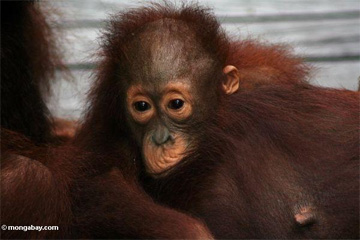 Kalimantan, 2006 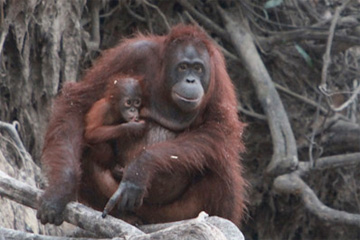 Kalimantan, 2009 |
“It took scientists decades to discover how to successfully reintroduce critically endangered orangutans from captivity into the wild. It could take APP just months to destroy an important part of their new habitat,” said Peter Pratje of the Frankfurt Zoological Society. “These lowland forests are excellent habitat for orangutans, which is why we got government permission to release them here beginning in 2002. The apes are thriving now, breeding and establishing new family groups.”
Some conservationists worry that developers may see reintroduction programs as an alternative to preserving orangutans in their natural habitat, thereby eliminating the need to mitigate their environmental transgressions.
“I see 90 percent of the role of rehabilitation as animal welfare,” Erik Meijaard, an ecologist working with The Nature Conservancy on orangutan conservation in Kalimantan, said. “The rehab programs attract a lot of international attention and with that political pressure (it’s the most visible sign of failing conservation management by the Indonesian authorities). But in the past these programs have done nothing to address the root causes of orangutan decline. In fact, the opposite might happen when displaced orangutans are taking care off by the rehab centers, thereby giving the impression that the centers will help the plantations to solve a problem. I know the latter is not the case, but I am not sure whether the plantations see it that way.”
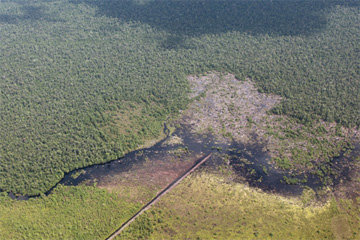 Kalimantan, 2009 |
Dave Dellatore, a primatologist with the Sumatran Orangutan Society/Orangutan Information Center (SOS-OIC), says conservation must address orangutans already in the rehabilitation system, while simultaneously slowing the number entering it and putting more back into nature.
“Rehabilitation and reintroduction were never intended to be a stand-alone solution, but are rather reactions to the greater problem of shrinking habitat and displacement of individuals from the forest therein. It’s an example of treating the symptom rather than the cause,” he said.
But concerns with reintroduction extend beyond land. Disease is a particular worry. Captive orangutans are more likely to carry disease and parasites due to their living in high density in captivity. Further ex-captives are prone to engage in behavior that puts them at risk of transmissions—living in closer proximity when reintroduced to the wild and approaching humans offering food. For example, mortality rates among orangutans visited by throngs of tourists in Sepilok and Bukit Lawang are over 50 percent.
“Under natural conditions, orangutans are semi-solitary and rarely congregate in groups. Ex-captives, due to their altered upbringing, may be more social once returned to the wild,” Dellatore of SOS-OIC explained.
 Kalimantan, 2009
|
Interaction with humans may alter behavior in other ways as well. Last year Dellatore reported two disturbing instances of mother orangutans cannibalizing their dead offspring. It was the first time the behavior had ever been recorded in orangutans. Dellatore attributed the aberrant conduct to stressful conditions caused by large numbers of tourists in Bukit Lawang, a site within Gunung Leuser National Park in Sumatra.
Genetic considerations, too, come into play in the reintroduction process. Due to genetic variation between populations—there are three sub-species of Bornean orangutan and the Sumatran form is an independent species—orangutans cannot be haphazardly reintroduced to the wild without knowledge of the individual’s origin. There are also legal issues. Indonesian law—though routinely ignored—forbids the reintroduction of rehabilitated orangutans to sites where there is a wild population. Part of this stems from disease concerns, but another factor is conflict with resident wild populations. Finally and most importantly, reintroduction to areas where people are present doesn’t bode well for orangutans if the needs of locals are not met.
“For reintroduction it is equally important to create a safe political environment as it is a physical environment. If a program is implemented from above with no care or attention given to the local community surrounding it, the project is likely doomed to fail,” Dellatore said.
Unlike many Westerners, most rural people in Borneo and Sumatra don’t see orangutans as peers worthy of protection. They view orangutans as pests that compete for food by ransacking crops and destroying livelihoods. Thus efforts to protect orangutans can foster the perception that conservationists care more about orangutans than people.
Addressing this “conservation versus human well-being” mentality is key to any solution. SOS-OIC, COP, and BOS run outreach programs that aim to reduce conflict between communities, plantation workers, and orangutans by demonstrating how to reduce crop losses due to orangutans and highlighting the importance of ecosystem services provided by habitats that also support orangutans. But talk only goes so far—it is difficult for people to grasp the value of these services until they are gone and they have to pay cash for water and forest products that were once free. Thus one hopeful area is emerging payments for ecosystem services schemes, which can make people partners rather than enemies of conservation.
“Many of us speak about balancing social, environmental, and economic values, but really we are in most cases talking about economics, economics, economics,” said The Nature Conservancy’s Meijaard. “If that’s the case the demise of orangutans and other species is mostly due to the fact that no one is willing or able to pay the opportunity costs of development.”
“Very few people care or have the luxury to care about their environment, and with the current legal uncertainty about who owns what, the clever thing to do is to milk the system as hard and as fast as you can. And that’s what pretty much everyone is doing.”
Acquiring land for orangutan conservation is expensive, because buyers—especially conservation groups that have to play by the book and can’t rely on the opaque arrangements sometimes employed by loggers and oil palm developers—have to pay the market rate for land. Further, conservation activities are expensive. While Willie Smitts’ remarkable “Restoring a Rainforest” project, which combined reforestation, conservation, and community development in Samboja Lestari, East Kalimantan is an inspiration; it took years and mountains of cash to implement. Thus payments for ecosystem services may offer an alternative model, financing conservation while supporting local people as stewards in sustainable development that makes human occupation more compatible with orangutans and the environment. Two studies, published recently in the journal Conservation Letters, bolster this idea by showing that robust forest carbon offsets generated under a proposed climate mitigation mechanism known as REDD (Reducing Emissions from Deforestation and Degradation) could be competitive with other forms of land use, including oil palm.
“We found that areas where emissions reductions are cheapest are also higher than average in endangered mammals, demonstrating that REDD has the potential to deliver win-wins for carbon and biodiversity objectives,” said Oscar Venter, a Ph.D. student at the University of Queensland and lead author of one of the studies.
Michelle Desillets agrees. The thrust of her Orangutan Land Trust will be to use these approaches to finance land acquisition and sustainable development activities among local communities.
“OLT and BOS have worked very hard to support sustainable production of palm oil in order to minimize the impacts on the environment. We have worked with the industry to try to improve procedures and to set aside conservation areas. This will have some effect, but many palm oil and timber companies do not concern themselves with the environment, and the only way that we can protect the forested areas that these players have their eyes on is to make these forests worth more standing than cut down or converted to oil palm.”
“We are looking at any number of models that bring in funds for the protection of the area. This includes carbon payments, bio-banking, perhaps sustainable forest management, and other ecosystem service payments such as water,” she said. “We are very hopeful that REDD will be adopted in Copenhagen, and that the details of this will work out in a way that benefits both biodiversity and communities.”
But given the vastness of Kalimantan and Sumatra, it’s going to take more than land acquisition to slow the influx of orphaned orangutans into rehabilitation centers. Improved governance will be critical in improving the plight of orangutans and the well-being of local communities, rooting out corruption, and implementing conservation schemes like REDD. The USAID-backed Orangutan Conservation Services Project program is working to do just this, focusing initially on improving law enforcement, identifying gaps in environmental regulations, and increasing coordination between groups. The program has projects across Kalimantan and Sumatra.
 Kalimantan, 2009 |
“Wehea forest in East Kalimantan is a great example of communities, local government, and local private sector supporting forest protection,” Meijaard said. “It’s a very rare example of conservation that works in Indonesia. Strong community leadership, strong support from local government and communities, very good management, and relatively low threats all add to the area having been completely secure for the last four years now.”
Finally, despite the challenges it’s important not to give up on rehabilitation efforts. The captive population does serve important functions. While orangutans aren’t in immediate danger of extinction with 54,000 in Borneo and 6,500 in Sumatra, it is a bulkhead against catastrophic fire (look no further than the el Nino fires of 1982-1983 and 1997-1998) or outbreak of disease. Rehabilitation programs also generate public awareness in conservation issues, which translates to political pressure to create protected areas and enforce environmental laws. And finally there is the issue of welfare. Conservationists cannot abandon the 2,000 or more orangutans currently in the rehabilitation system. After all, baby orangutans currently in captivity should be able to enjoy a future where they can dig with tools in forest logs rather than in plastic pipes at a survival center.
Related articles
Borneo ablaze: forest fires threaten world’s largest remaining population of orangutans
(08/16/2009) Raging fires have broken out in the peat-swamp forests of Central Kalimantan, Indonesian Borneo, threatening the largest population of orangutans in the world. The fires were started by people but have spread uncontrollably due to the extreme drought that Borneo is currently experiencing as a result of El Niño conditions.
Turning wasteland into rainforest
(07/31/2009) The highly touted reforestation project launched by orangutan conservationist Willie Smits in Indonesian Borneo is detailed in this week’s issue of Science.
Borneo orangutan release in jeopardy over fate of coal mining concession
(07/29/2009) A plan to release orangutans in a 250,000-hectare (618,000-acre) tract of forest in the Heart of Borneo has been disrupted by uncertainty around BHP Billiton’s decision to pull out of a coal mining project in Kalimantan, the Indonesian part of Borneo, reports the Independent and conservation groups familiar with the situation. BHP Billiton had provided funds to help establish the forest reserve in Central Kalimantan and offered conservationists mapping support and use of helicopters to deposit orangutans into otherwise inaccessible areas. The two-year program would have reintroduced scores of orangutans but the first scheduled airlift of 48 orangutans for July 20 was canceled after BHP warned it could no longer guarantee the safety of reintroduced orangutans.
Multinational corporation continues destruction of orangutan habitat in Indonesia
(07/09/2009) A coalition of environmental groups stepped up efforts to stop Astra Agro Lestari (AAL), an Indonesian palm oil company, from continuing to clear orangutan habitat in Aceh province, Indonesia.
Malaysian palm oil chief claims oil palm plantations help orangutans
(06/18/2009) Dr. Yusof Basiron, CEO of the Malaysian Palm Oil Council, the government-backed marketing arm of the Malaysian palm oil industry, claims on his blog that endangered orangutans benefit from living in proximity to oil palm plantations. Environmentalists scoff at the notion, maintaining that oil palm expansion is one of the greatest threats to orangutans.

(06/04/2009) A new paper by Oscar Venter, a PhD student at the University of Queensland, and colleagues finds that forest conservation via REDD — a proposed mechanism for compensating developing countries for Reducing Emissions from Deforestation and Degradation — could be economically competitive with oil palm production, a dominant driver of deforestation in Indonesia. The study, based on overlaying maps of proposed oil palm development with maps showing carbon-density and wildlife distribution in Kalimantan (Indonesian Borneo), estimates that REDD is financially competitive, and potentially able to fund forest conservation, with oil palm at carbon prices of $10-$33 per ton of carbon dioxide equivalent (tCO2e). In areas with low agricultural suitability and high forest carbon, notably peatlands, Venter and colleagues find that a carbon price of $2 per tCO2e would be sufficient to beat out returns from oil palm.
Orangutan guerrillas fight palm oil in Borneo

(06/01/2009) Despite worldwide attention and concern, prime orangutan habitat across Sumatra and Borneo continues to be destroyed by loggers and palm oil developers, resulting in the death of up to 3,000 orangutans per year (of a population less than 50,000). Conservation groups like Borneo Orangutan Survival report rescuing record numbers of infant orangutans from oil palm plantations, which are now a far bigger source of orphaned orangutans than the illicit pet trade. The volume of orangutans entering care centers is such that these facilities are running out of room for rescued apes, with translocated individuals sometimes waiting several months until suitable forest is found for reintroduction. Even then they aren’t safe; in recent months loggers have started clearing two important reintroduction sites (forests near Bukit Tigapuluh National Park in Sumatra and Mawas in Central Kalimantan). Meanwhile across half a dozen rehabilitation centers in Malaysia and Indonesia, more than 1,000 baby orangutans—their mothers killed by oil palm plantation workers or in the process of forest clearing—are being trained by humans for hopeful reintroduction into the wild, assuming secure habitat can be found. Dismayed by the rising orangutan toll, a grassroots organization in Central Kalimantan is fighting back. Led by Hardi Baktiantoro, the Center for Orangutan Protection (COP) has mounted a guerrilla-style campaign against companies that are destroying orangutan habitat in Kalimantan, the Indonesian part of Borneo.
APP, Sinar Mas plan to log habitat of critically endangered orangutans

(05/20/2009) Asia Pulp & Paper and Sinar Mas Group have acquired a license to clear hundreds of hectares of unprotected rainforest near Bukit Tigapuluh National Park on the Indonesian island of Sumatra, report environmental groups who say the activity threatens a population of critically endangered orangutans that have been re-introduced into the wild. The companies intend to log the concession for timber and plant it for industrial timber and oil palm plantations.
Large population of rare black orangutans found in Borneo
(04/13/2009) A large population of orangutans has been documented by conservationists conducting a survey in a remote part of Indonesia Borneo.
Orangutans persist in islands amid a sea of oil palm plantations
(07/17/2008) Orangutan are surviving in forest islands in a sea of oil palm plantations in Malaysia, reports a new survey by a government-backed conservation initiative. The finding underscores the need to protect critical forest areas for the endangered primates as forest continues to fall in southeast Asia at a rate that is the highest of any of the world’s tropical forest regions.
Orangutan populations drop due to logging, expansion for palm oil
(07/03/2008) Orangutan populations have fallen sharply on the two islands where they still live, reports a new study published in the journal Oryx.
Orangutan should become symbol of palm-oil opposition
(01/02/2008) In a letter published today in Nature, Oscar Venter, Erik Meijaard and Kerrie Wilson argue that proposals for conservation groups to purchase and run oil palm plantations for the purpose of generating funds for forest protection are unlikely to be successful. The concept was originally put forth by Lian Pin Koh and David S. Wilcove in a 2007 Nature article.
98% of orangutan habitat gone in next 15 years

(06/11/2007) Indonesia is losing more than 2.1 million hectares (5.2 million acres) of forest a year to illegal loggers, states a new report from the U.N. Environment Program (UNEP). The report, which estimates the value of illicit timbering at $4 billion annually, warns that 98 percent of Indonesia’s lowland forests will be gone by 2022, putting species like the orangutan at risk of extinction in the wild. The report, Last stand of the Orang-utan: State of Emergency, was released Monday at the Convention on International Trade in Endangered Species meeting in The Hague.
Orangutan population plunges 43% in Indonesia
(08/14/2006) The Wildlife conservation Society-Indonesia Program said that Indonesia’s population of orangutans fell nearly 43 percent in the past decade, from 35,000 in 1997 to 20,000 today. The decline has been caused by ongoing forest destruction and poaching in Kalimantan (Borneo) and Sumatra, the only two islands that still support wild orangutans. Environmental groups have warned that red ape could be extinct in the wild without urgent conservation measures.
(05/24/2006) A look at conservation efforts in Kalimantan, on the island of Borneo. I’m in Tanjung Puting National Park in southern Kalimantan on the island of Borneo. At 400,000 hectares (988,000 acres) Tanjung Puting is the largest protected expanse of coastal tropical heath and peat swamp forest in southeast Asia. It’s also one of the biggest remaining habitats for the critically endangered orangutan, the population of which has been great diminished in recent years due to habitat destruction and poaching. And orangutans have become the focus of a much wider effort to save Borneo’s natural environment. We are headed to Campy Leakey, named for the renowned Kenyan paleontologist Louis Leakey. Here lies the center of the Orangutan Research conservation Project. Established by Birute Mary Galdikas, a preeminent primatologist and founder of the Orangutan Foundation International (OFI), the project seeks to support the conservation and understanding of the orangutan and its rain forest habitat while rehabilitating ex-captive individuals. The Orangutan Research conservation Project is the public face of orangutan conservation in this part of Kalimantan, the Indonesia-controlled part of Borneo. Borneo, the third largest island in the world, was once home to some of the world’s most majestic, and forbidding forests. With swampy coastal areas fringed by mangrove forests and a mountainous interior, much of the terrain was virtually impassable and unexplored. Headhunters ruled the remote parts of the island until a century ago.
Why is palm oil replacing tropical rainforests?
(04/25/2006) In a word, economics, though deeper analysis of a proposal in Indonesia suggests that oil palm development might be a cover for something more lucrative: logging. Recently much has been made about the conversion of Asia’s biodiverse rainforests for oil-palm cultivation. Environmental organizations have warned that by eating foods that use palm oil as an ingredient, Western consumers are directly fueling the destruction of orangutan habitat and sensitive ecosystems. So, why is it that oil-palm plantations now cover millions of hectares across Malaysia, Indonesia, and Thailand? Why has oil palm become the world’s number one fruit crop, trouncing its nearest competitor, the humble banana? The answer lies in the crop’s unparalleled productivity. Simply put, oil palm is the most productive oil seed in the world. A single hectare of oil palm may yield 5,000 kilograms of crude oil, or nearly 6,000 liters of crude.
Study finds deforestation has pushed orangutans to brink of extinction
(01/24/2006) A three year genetic study by wildlife geneticists from Cardiff School of Biosciences has shown a population collapse in the Bornean orang-utan.
